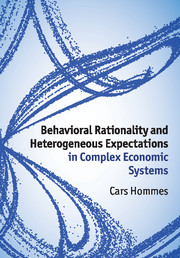Book contents
- Frontmatter
- Contents
- Figures
- Preface
- 1 Introduction
- 2 Bifurcations and chaos in 1-D systems
- 3 Bifurcations and strange attractors in 2-D systems
- 4 The nonlinear cobweb model
- 5 The cobweb model with heterogeneous expectations
- 6 An asset pricing model with heterogeneous beliefs
- 7 Empirical validation
- 8 Laboratory experiments
- Bibliography
- Index
8 - Laboratory experiments
Published online by Cambridge University Press: 05 February 2013
- Frontmatter
- Contents
- Figures
- Preface
- 1 Introduction
- 2 Bifurcations and chaos in 1-D systems
- 3 Bifurcations and strange attractors in 2-D systems
- 4 The nonlinear cobweb model
- 5 The cobweb model with heterogeneous expectations
- 6 An asset pricing model with heterogeneous beliefs
- 7 Empirical validation
- 8 Laboratory experiments
- Bibliography
- Index
Summary
In Chapter 6 we have seen many examples of the simple asset pricing model with heterogeneous beliefs exhibiting complex dynamics characterized by temporary bubbles and crashes, triggered by exogenous news about economic fundamentals and strongly amplified by self-fulfilling expectations and trend-following trading strategies. While the previous chapter focused on the empirical relevance of the heterogeneous expectations switching model by comparing it to real financial time series, the current chapter confronts the heterogeneous expectations switching model with laboratory experimental data, both at the individual micro and at the aggregate macro level. Laboratory experiments with human subjects are well suited to discipline the class of behavioral modes or individual heuristics that boundedly rational subjects may use in economic decision making. This chapter discusses a number of “learning-to-forecast experiments” in the cobweb and asset pricing framework, where human subjects must forecast the price of an asset or a commodity, whose realized market price is an aggregation of individual expectations. These experiments may be seen as a testing of the heterogeneous expectations hypothesis in the lab. This chapter is based on the survey of laboratory experiments in Hommes (2011), with some recent updates.
In real markets, it is hard to obtain detailed information about individual expectations. One way to collect data on individual expectations is by survey data analysis; see, e.g., Pesaran and Weale (2006) for a stimulating overview. Survey data analysis can focus exclusively on the expectations-generating process, avoiding the dilemma of testing joint hypotheses. There is already quite some evidence on forecasting heterogeneity in survey data. Frankel and Froot (1987, 1990a and b), Allen and Taylor (1990) and Taylor and Allen (1992), for example, found that financial experts use different forecasting strategies to predict exchange rates. They tend to use trend extrapolating rules at short horizons (up to 3 months) and mean-reverting fundamentalists rules at longer horizons (6 months to 1 year). Moreover, the weight given to different forecasting techniques changes over time. Shiller (1987, 2000) and Vissing-Jorgensen (2003) present evidence of heterogeneity and time variation in the sentiment of investors in stock market data. For example, Shiller (2000) finds evidence that investor's sentiment changes over time, with both institutions and individual investors becoming more optimistic in response to recent significant increases of the stock market in the late 1990s. Mankiw et al. (2003), Capistran and Timmermann (2009) and Pfajfar and Santoro (2010) find evidence for heterogeneity and time variation in inflation expectations.
- Type
- Chapter
- Information
- Publisher: Cambridge University PressPrint publication year: 2013
- 2
- Cited by



